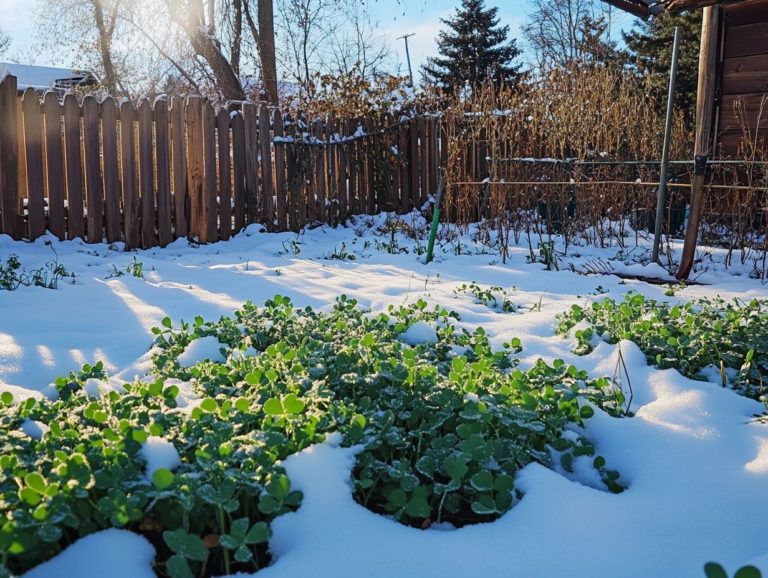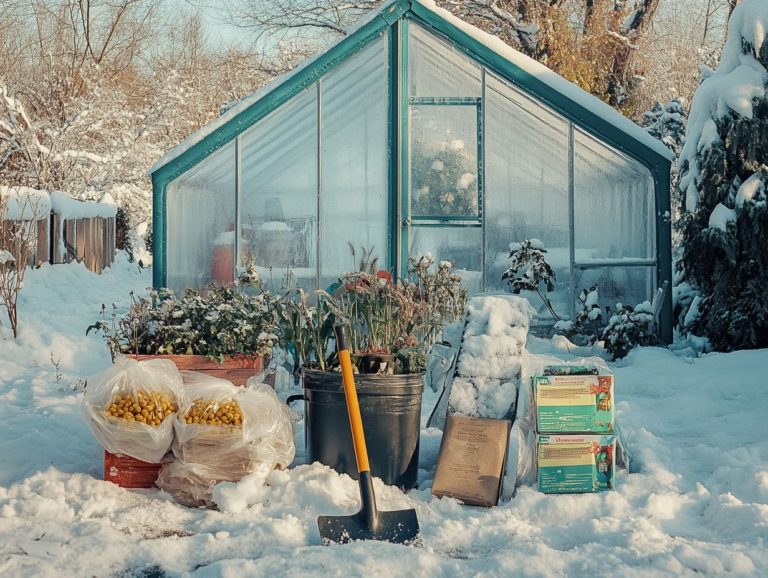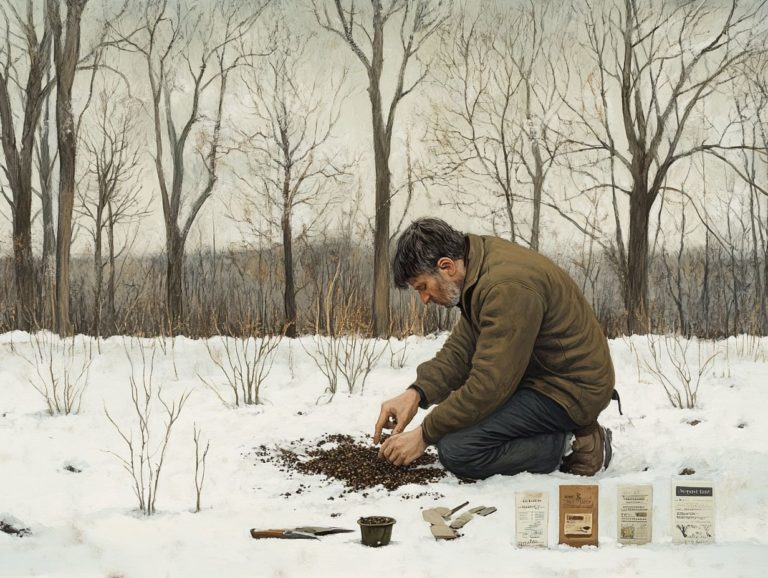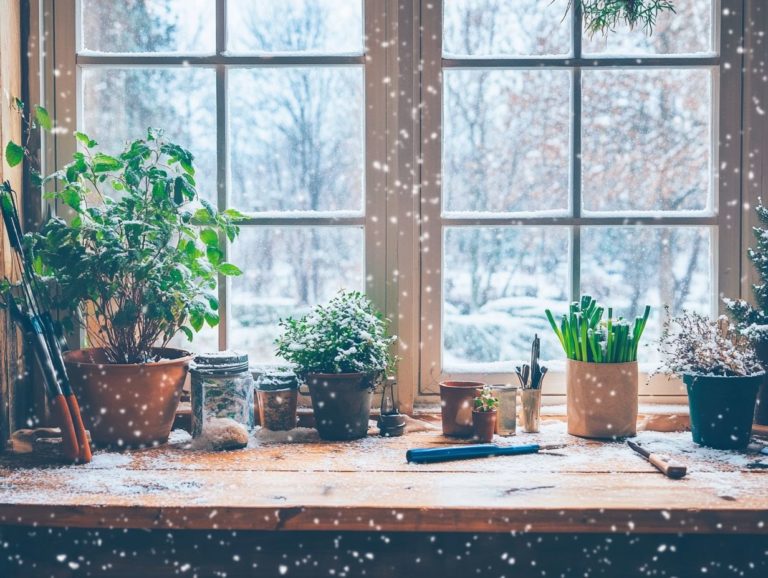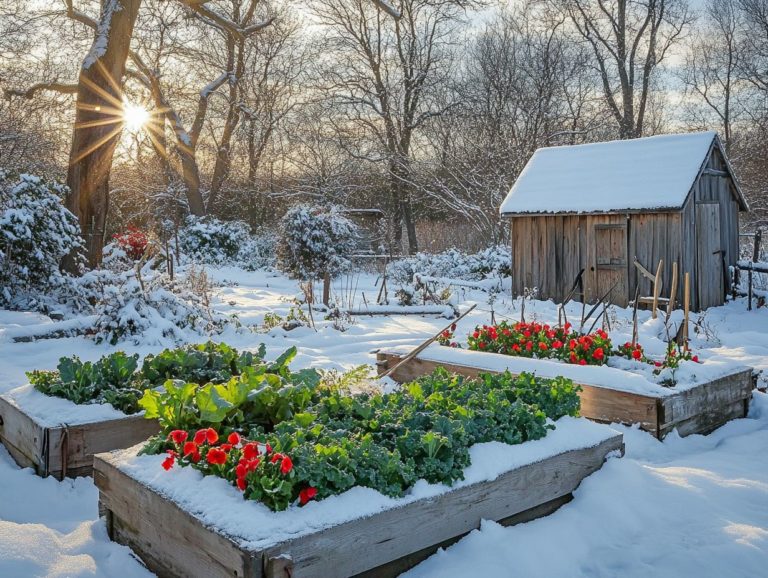Essential Tools for Winter Gardening Success
Winter gardening might seem a bit intimidating at first, but it presents a great opportunity for both novice and seasoned gardeners alike.
By grasping the benefits and familiarizing yourself with the essential tools, you can successfully nurture your plants through the chillier months. This guide is designed to unveil the advantages of winter gardening, recommend the perfect tools for planting and protection, and share tips to enhance your success.
Embrace the beauty of winter and ensure your garden thrives beautifully throughout the year!
Contents
- Key Takeaways:
- Benefits of Winter Gardening
- Essential Tools for Winter Gardening
- Tips for Maximizing Winter Gardening Success
- Frequently Asked Questions
- What tools do I really need for winter gardening?
- Do I need any special tools for winter gardening?
- How do I take care of my tools during the winter?
- Can I use the same tools for both winter and summer gardening?
- What should I look for when purchasing gardening tools?
- Are there any alternative tools I can use for winter gardening?
Key Takeaways:
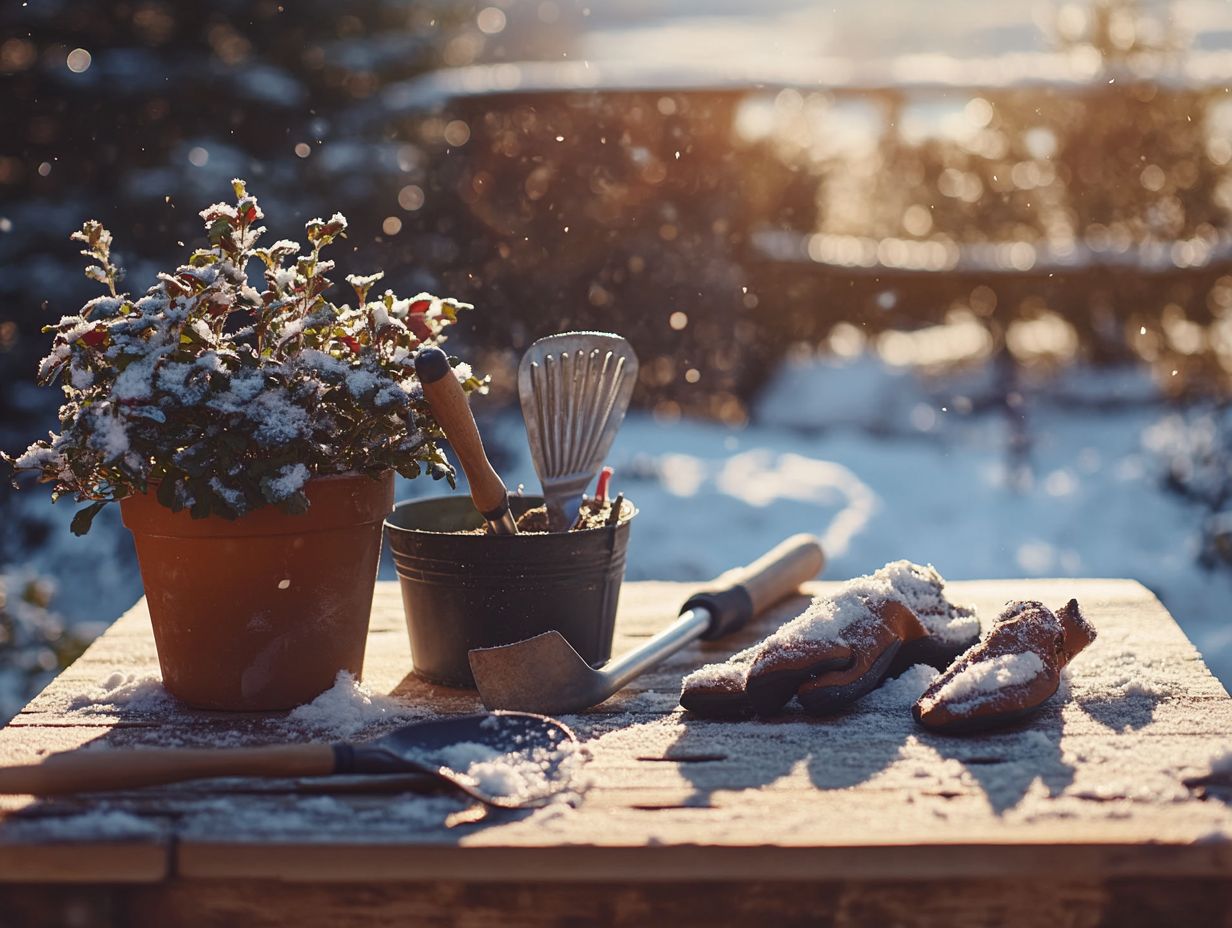
- Invest in high-quality tools designed for winter gardening, such as sturdy shovels, durable pruners, and protective covers.
- Prepare your garden for the colder months by clearing debris, adding mulch, and protecting delicate plants with frost cloths or cold frames.
- Choose cold-hardy plants and provide proper care, such as watering only when necessary and avoiding over-fertilization, to ensure successful growth and winter survival.
What is Winter Gardening?
Winter gardening is the art of cultivating plants throughout the colder months, using specific techniques and tools to ensure growth and sustainability, even in chilly climates. This approach has become increasingly popular in urban gardening, where space can be tight, and gardeners are eager to maintain productivity all year long.
In vibrant regions like Melbourne and Adelaide, winter gardening often involves selecting robust winter crops and engaging in effective seasonal pruning to prepare for the blossoming growth of spring.
These practices not only enable plants to survive but also thrive under the right conditions. Techniques like cold frames (structures that trap heat) and hoop houses (temporary greenhouses) effectively regulate temperature and shield plants from harsh weather.
Varieties such as kale, broccoli, and winter carrots are particularly well-suited to winter gardening, as they are resilient against frost and can even enhance their flavor after a good chill. By maintaining healthy soil through mulching and organic amendments, you ensure that nutrients are preserved, making it easier for your plants to flourish when the warmth of spring returns.
By embracing winter gardening, you join a vibrant community that celebrates year-round cultivation and sustainability.
Benefits of Winter Gardening
Winter gardening presents a wealth of benefits that elevate both plant health and your satisfaction as a gardener. This sustainable approach minimizes waste while maximizing yield. It creates an enriching experience.
Investing in high-quality tools like comfortable gardening implements and embracing effective composting methods, including using compost and soil amendments, allows you to cultivate a thriving soil environment that nurtures winter crops and sets the stage for a vibrant spring revival.
Advantages for Plants and Gardeners
The advantages of winter gardening are truly multifaceted, benefiting both your plants and your gardening experience through enhanced growth and improved maintenance strategies. Incorporating winter gardening tools and practices can significantly reduce physical strain while ensuring your winter crops receive the care they deserve.
This approach not only leads to healthier plants but also nurtures a deeper connection between you and your green spaces. During the cold months, maintaining a garden might seem daunting, but that s where specific tools like the Hori Hori knife and hand pruners come to your rescue.
The Hori Hori s versatile blade is perfect for efficient planting and soil aeration, promoting robust root development in those hearty winter vegetables. Meanwhile, hand pruners allow for precise trimming, encouraging vigorous growth in your dormant plants.
Winter gardening also offers psychological benefits. Nurturing your plants can bring a sense of tranquility and purpose. Engaging with the soil and witnessing even the tiniest signs of life can uplift your spirits, fostering resilience during these chilly months.
You may even find solace in the quiet beauty of frost-kissed leaves, transforming winter into a canvas of natural artistry.
Start your winter gardening journey today and enjoy the beauty of nature all year round!
Essential Tools for Winter Gardening
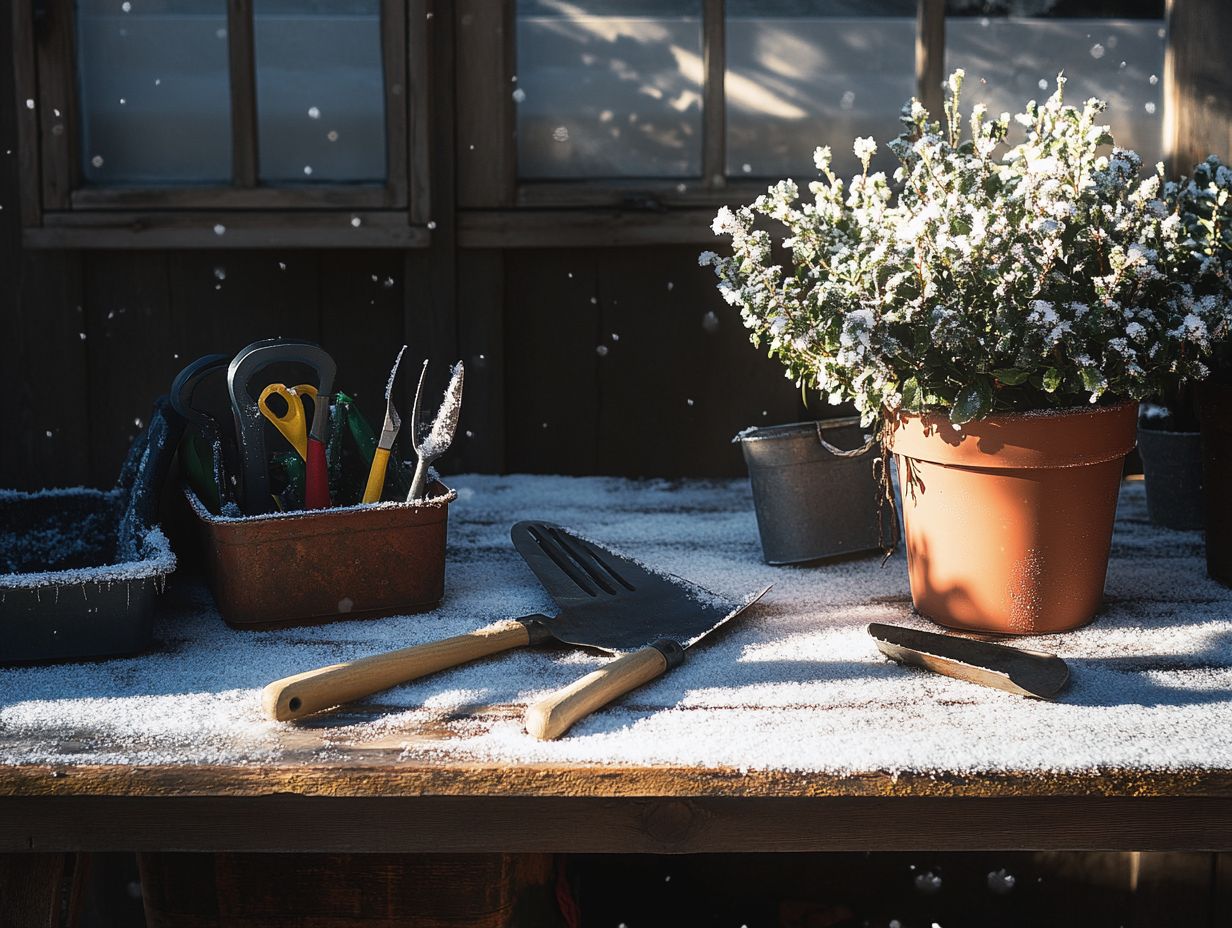
Essential tools for winter gardening are vital, as they ensure your plants receive the care they need during the colder months. For a comprehensive list, check out the top 10 must-have tools for winter gardening.
Investing in high-quality tools tailored for specific tasks is important. Options like planting tools, garden trowels, and ergonomic implements elevate both efficiency and enjoyment.
Proper tool care extends their longevity. This allows you to cultivate your garden with ease and confidence during tasks like dividing plants or weeding.
Tools for Planting and Maintenance
Having the right tools for winter gardening is essential. For effective cold-climate gardening, knowing what tools are essential can facilitate proper care for crops and improve soil health.
Investing in durable tools is crucial. High-quality products provide a superior user experience and last longer.
Brands like Felco offer exceptional hand pruners, known for precision and ease of use. Burgon & Ball trowels are designed for comfort, making them ideal for digging.
A sturdy spade or fork is invaluable for mixing compost with soil. Choosing reliable tools enhances your gardening performance.
Tools for Protecting Plants
Effective tools for protecting plants from frost are crucial in winter gardening. To learn more, check out how to create a winter gardening toolkit. Ergonomic implements help you tackle harsh winter challenges.
Use frost covers and row covers to protect against ice and frigid temperatures. These coverings insulate plants while allowing sunlight and moisture in.
Ergonomic tools make it easier to apply and adjust coverings. Incorporating mulch around plants helps regulate soil temperature.
Using the right techniques with thoughtful tools ensures your winter garden is productive. Check out the ultimate guide to cold weather gardening tools to make it a sustainable endeavor.
Tips for Maximizing Winter Gardening Success
Maximizing success in winter gardening requires strategic planning. For instance, understanding the importance of quality garden tools in winter can significantly aid in overcoming seasonal challenges. Thoughtful implementation of techniques can help navigate these obstacles effectively.
Embrace practices like indoor gardening techniques and using plant labels. Effective crop protection methods, like frost protection, help cultivate a vibrant green space.
Preparing the Garden
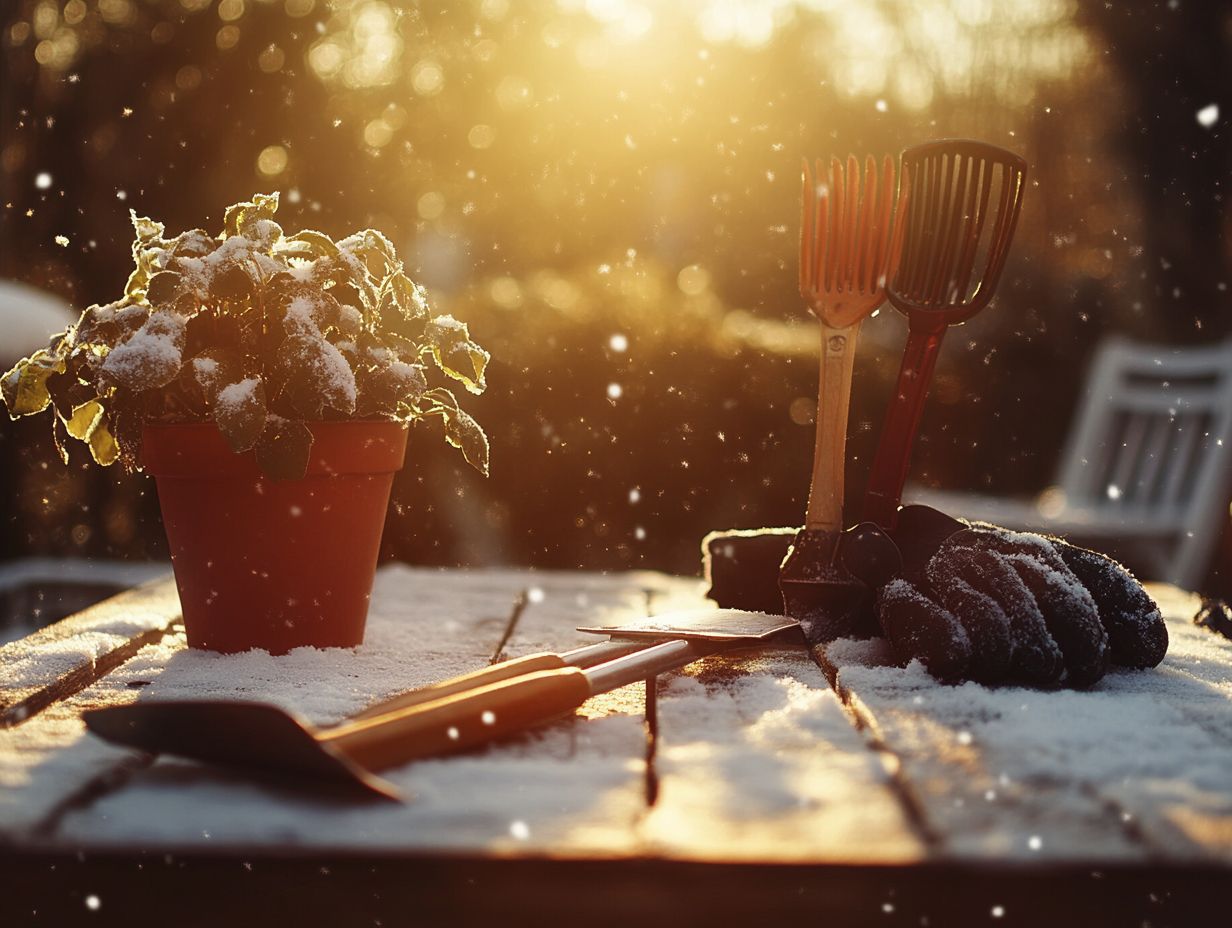
Preparing your garden for winter involves essential steps that set the stage for thriving plant growth while safeguarding soil health. Start with some garden maintenance, apply compost, and make soil amendments to enhance nutrient availability. Invest in ergonomic tools to ease the physical demands of gardening as the chill sets in.
Begin with a thorough cleanup of fallen leaves and debris to prevent pests and diseases from overwintering in your soil. Adding organic compost will not only enrich the soil but also improve its structure and water retention capacity. This makes it more resilient against harsh winter conditions.
Incorporate soil amendments like lime or sulfur to help balance pH levels. This creates a hospitable environment for helpful tiny organisms that support healthy soil. Employ mulch as a protective layer; it insulates the soil and suppresses weeds, facilitating a smoother transition into spring gardening. Engaging in these practices can significantly boost your garden’s vitality when the warmer months return.
Choosing the Right Plants
Choosing the right plants for winter gardening is vital for ensuring a bountiful and sustainable garden experience. Certain varieties thrive in colder conditions, so opt for resilient winter crops like select perennials and hardy vegetables to enhance the diversity and productivity of your garden. With the right choices, you can enjoy year-round harvesting.
Include kale, Brussels sprouts, and specific root vegetables these are well-suited to frosty climates and provide essential nutrients during the colder months. By adding perennial plants like winter savory and rosemary, you indulge in culinary delights while fostering ecological balance within your garden.
Implement seasonal pruning strategies to prepare your plants for winter, promoting their health and vigor for the upcoming growing season. Embrace sustainable gardening practices like composting and mulching to further enrich the soil, cultivating a thriving environment for your cold-weather crops.
With thoughtful planning and selection, you’re on your way to a fruitful winter garden that benefits both you and the ecosystem!
Caring for Plants During Winter
Your plants need your care this winter to thrive! Employ tools like a watering can and crop protection strategies to maintain plant health, especially as you transition between indoor gardening and outdoor practices.
To manage this seasonal shift, adjust your watering schedules since plants usually require less moisture in colder months. Monitoring humidity levels is vital, as indoor heating can dry out the air and pose a risk to delicate foliage.
Utilizing protective covers or relocating potted plants away from drafty windows can shield them from harsh temperatures. Regularly check for pests and diseases to safeguard against winter-related issues.
Embrace indoor gardening techniques, such as using grow lights, to ensure your plants receive sufficient light, promoting healthy growth even during dim winter days. With a keen eye and proactive care, you can cultivate a thriving winter garden.
Frequently Asked Questions
What tools do I really need for winter gardening?
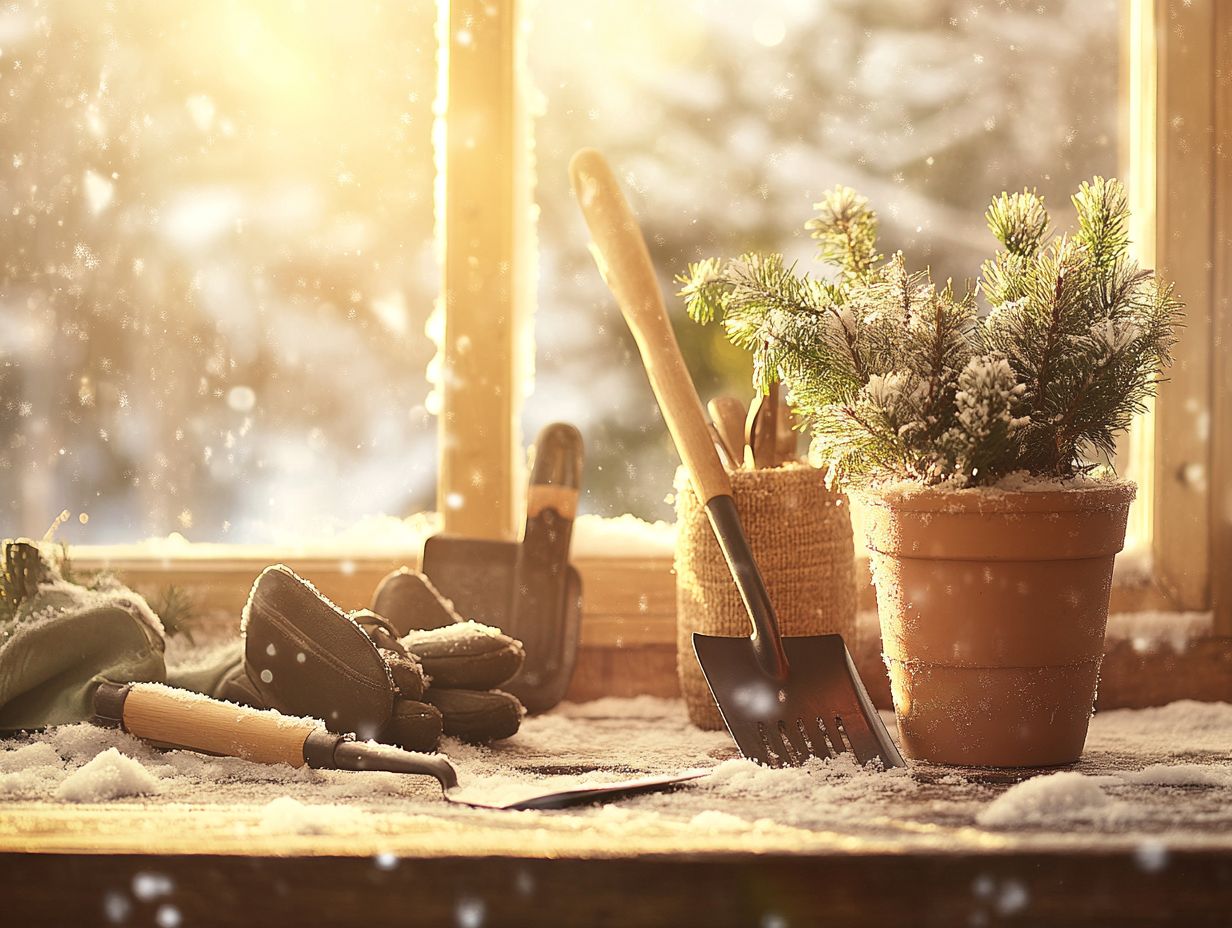
The essential tools for winter gardening success include a shovel, hand pruners, a rake, a watering can or hose, a pair of gardening gloves, and a trowel. To make sure you’re fully prepared, check out these essential winter gardening supplies you need. These tools will help you with basic gardening tasks such as digging, pruning, raking, watering, and planting.
Do I need any special tools for winter gardening?
While the essential tools listed above are sufficient for most winter gardening tasks, consider investing in a hand cultivator, a garden fork, and a mini greenhouse. For more specialized work, check out gardening in the snow: essential tools. These tools can help with specific tasks, such as loosening the soil, removing weeds, and protecting delicate plants from harsh weather.
How do I take care of my tools during the winter?
Caring for your tools during the winter is important for their longevity and effectiveness. Clean and dry your tools after each use. Store them in a dry, sheltered location.
Make sure to oil metal parts to prevent rusting. Don’t forget to sharpen your tools before storing them for winter.
Can I use the same tools for both winter and summer gardening?
Some essential tools for winter gardening, like hand pruners and a trowel, can also be used in summer. However, to enhance your winter gardening experience, you might consider learning how to make your own cold-weather gardening tools, as some tools are specific to each season.
For example, a snow shovel and a mini greenhouse aren’t necessary for summer gardening, while a hoe and a watering can may be more useful in the warmer months.
What should I look for when purchasing gardening tools?
When purchasing gardening tools, look for well-made and durable options. Choose tools made from high-quality materials, like stainless steel or carbon steel, to ensure they last for multiple seasons.
Read reviews and compare prices to find the best tools for your budget.
Are there any alternative tools I can use for winter gardening?
If you’re on a tight budget or lack traditional gardening tools, there are alternative options for winter gardening.
For example, use a plastic jug with holes punched in the lid as a watering can, or repurpose an old kitchen knife as a hand pruner. Ensure the tools are clean and sharp for safe and effective use.


